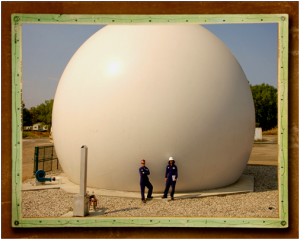My CBC column last Friday took a different tact than usual. In San Francisco I attended a number of sessions looking at environmental initiatives underway at a number of U.S. craft breweries. It was inspirational stuff – 100% composting of waste material, biomass co-generation (see photo), water and energy efficiencies. I was left seriously thinking about how craft beer can really find a way to achieve the overused “triple bottom line”. I normally hate that phrase as it feels like empty jargon, but I think I got a glimpse of what it could mean. Craft brewers understand what it means to put something ahead of profit. They do it with quality every day. Plus most are connected to their community. That grounding can lead naturally to a more concerted effort to reduce their carbon footprint and other environmental effects.
So inspired, I made my column about greening beer. First I looked at what the local kids are doing – and it is more than you might think. Lots of effort to capture heat and cold for other purposes, to reduce water use and minimize energy costs. This makes sense, as most of these initiatives both help the environment and their bottom line. And we can’t forget about Alley Kat’s decision to make Charlie Flint organic. Of course there is a limit to what the local micros can do – simply because of scale and money. So, I turned to a couple of the big projects I heard about in San Francisco. Nothing more than a snapshot of what is possible, but interesting nonetheless.
In hindsight, I think I should have turned it into a two-part series, as it would have given me more time to expand on some important things. Alas, I was not smart enough to think of that before.
You can here the column here. I suspect I may return to this topic again in the future – as it is one of those rare issues that combines good beer with substantive issues that affect our future.



April 20, 2011 at 5:09 PM
Some good innovation & implementation to minimize power consumption/maximize water usage(while minimizing consumption), help out on the sustainability, etc. I also notice that on their drinks menu for the southside location, Urban Diner mentions that Toronto’s Steamwhistle Brewing is apparently rated the most environmentally friendly brewery in Canada. They incorporate renewable energy, energy efficient lighting & equipment, steam heating, painted labels on mega(re)use bottles, a waste diversion program & biofueled vehicles.